My pomodoro sauce is a classic Italian tomato sauce. It’s sublimely flavored with the bright, fresh, sunny flavors of Italy.
The ingredients are simple and easy to find. It’s quick to put together so it makes the perfect sauce to toss with pasta for a busy weeknight dinner.
Pomodoro Sauce Recipe
Moreover, love that I can make this delicious restaurant-quality pasta sauce literally in the time it takes to turn on a pot of water for my pasta, bring it to a roiling boil and cook my pasta to al dente. If you grew up eating authentic Italian food then this is a dish you’re going to love.
This recipe was given to me by a dear family member from my husband’s side of the family. It was handwritten and explained to me in a beautiful Italian accent. It’s different than many other versions I’ve tried and seen on the internet but let me tell ya, it is so wonderful I know you will love it!
We leave the tomatoes hand or spoon crushed rather than puree them. No immersion blender is needed. I like the rustic quality this style produces. Close your eyes, take a bit, and you’re transported to an Italian farmhouse in Tuscany!
Try more of my authentic Italian sauces next: Italian Sunday Gravy (seriously the most authentic and delicious you will ever, ever taste!), homemade Marinara Sauce, Italian spaghetti sauce, and my Ragu Bolognese. I promise all of these are Nonna approved!
What is Pasta Pomodoro Sauce
Pomodoro is the Italian word for tomato. So, simply put, this is pasta with tomato!
What does Pomodoro sauce taste like? If you’re not familiar with this sauce let me describe it. It’s a light tomato sauce with nice big chunks of tomatoes. The backbone of the sauce is olive oil that has gently been flavored with sweet mellow garlic.
It’s not like a spaghetti sauce that thickly coats the pasta with sauce. It’s like a cross between a chunky tomato sauce and Aglio e olio.
What Is The Difference Between Pomodoro Sauce vs. Marinara Sauce
Marinara sauce is a thick tomato sauce that is intended to coat the pasta. The pieces of tomato are almost completely blended down with just a bit of texture in Marinara.
My Pomodoro sauce is loaded with savory prosciutto, thick chunks of tomatoes, slices of golden garlic, basil, Italian parsley, and olive oil. No onions in this one! The tomato sauce component isn’t as thick as it is in a marinara sauce.
Is Pomodoro Sauce Spicy?
Typically, it is not at all a spicy sauce. My recipe isn’t spicy at all either. Now if you love spicy, don’t despair. You can use the ingredient most Italians add when they want a little heat.
Make this spicy by adding crushed red chili flakes to the olive oil and garlic. The longer the crushed red chili flakes are cooked the hotter they will be. So, if you want to add a hint of heat, throw them in the olive oil right before the garlic is done.
Alternately, if you want it really hot, add the red chili flakes as soon as you start to heat the oil. Also, you can adjust the heat by the number of chili flakes added.
Ingredients You’ll Need To Make This Quick Pomodoro Sauce
- Extra-virgin olive oil: As I said before, the olive oil in this recipe is the backbone of the sauce. Make sure you use only a high oil. Don’t try to cut down the amount used. It just doesn’t work with less olive oil.
- Garlic
- Prosciutto
- Fresh Basil Leaves: Fresh herbs make all the difference. Don’t use dried basil.
- Dry Bay Leaf: Okay…Okay! I said to use fresh herbs. I meant except for the bay leaf. I likely would prefer fresh but find fresh bay leaves aren’t accessible yet at most supermarkets.
- Italian Parsley: In a pinch, you can use curly parsley.
- White Wine
- San Marzano Tomatoes: For this sauce, I always use the San Marzano tomatoes imported from Italy. Be careful when you grab a can of these because there are San Marzano tomatoes that are not from Italy and they are not the same. I fell for this once!
- Reserved Pasta Water: This is the secret ingredient in this recipe! Trust me it will make all the difference in the finished dish. Using a heat-proof measuring cup with a handle (like a pyrex liquid measuring cup), scoop out about 1 cup of the pasta water right before you drain the pasta.
- The pasta water contains salt and starch from cooking the pasta and helps emulsify the parmesan cheese and smooth out the sauce.
- Spaghetti: Use good-quality pasta like De Cecco or Barilla.
- Parmesan cheese: You’ll get the best quality and taste from grating Parm from a wedge. I grate it at home by cutting the wedge into large chunks with a chef’s knife, then pulsing it in a food processor to get the desired consistency. You can also grate it with a micro planer.
- I prefer the thicker texture of the cheese processed in the food processor in this recipe. If you want, you can buy the tubs of grated Parm from the deli section, instead. Just don’t use the stuff in the green jar.
- Butter: Adds a velvety texture to this sauce. If you’re freaked out because this sauce already requires a lot of olive oil, yes you can skip it. But remember, adding butter to red sauce is a trick from the amazing Marcella Hazan!
What To Serve With Pomodoro Sauce
This sauce is typically tossed with spaghetti but any pasta will do. Just make sure you use 12 ounces, not the full pound of dried pasta. That way there will be the perfect pasta to sauce ratio. It’s also great served over grilled chicken, fried eggplant, or gnocchi.
I love to serve a fresh green salad tossed with my 5-minute homemade balsamic vinaigrette and olive garden breadsticks.
How To Make Pomodoro Sauce Recipe
- Slice the prosciutto. Set aside.
- Brown the garlic in olive oil.
-
Add prosciutto, basil, bay leaf, and parsley, and continue to cook over medium heat.
- Pour in the wine, then pour in tomatoes and break them up, with a wooden spoon. Add sugar, salt, and pepper. Bring sauce to a boil, reduce heat, and simmer until liquid is reduced by half. Reduce heat and gently simmer continue to 20 minutes.
- When ready to serve, add the drained pasta to the warm sauce and heat on low heat. Toss. Add half the parmesan cheese and reserved pasta water, continuing to toss. Serve in individual pasta bowls.
Storing/Freezing Tips, Serving Recommendations
- How Long Can You Keep This In The Fridge? Once made, the marinara sauce will last you about 3-4 days in the fridge.
- If you served this sauce over noodles, I’d store the sauce and pasta separately in the fridge. The longer noodles sit in sauce, the more liquid they absorb, turning them mushy and losing their structure.
- Can You Freeze This? This freezes really well. You can freeze it in any freezer-safe food-grade container or gallon-size Ziploc if you need freezer space. It’s best to slow thaw it in the fridge and then reheat it on the stove. This can be stored for 4-6 months.
- Make-Ahead Tips: I love to whip up a double batch of this awesome recipe and throw one in the freezer. Leftovers get divvied up into single-serve portions that I can grab for ready-made lunches or have for dinner.
More REAL Italian Recipes
- Chicken Milanese
- Weeknight Bolognese
- Chicken Scarpariello
- Italian Baked Meatballs
- Chicken Vesuvio
- Sicilian Meatballs
- Classic Italian Christmas Cookies
- Italian Wedding Cookies
Pomodoro Sauce
Ingredients
- 1/4 cup olive oil
- 12 large cloves garlic, thinly sliced
- 3 ounces prosciutto, thinly sliced
- 1/3 cup fresh basil, coarsely chopped
- 1 dry bay leaf
- 2 tablespoons flat leaf Italian parsley,
- 1/3 cup white wine
- 1 (28-ounce) can San Marzano peeled tomatoes, with juices from can
- 1/4 teaspoon granulated sugar
- 3/4 teaspoon salt
- 1/4 teaspoon black pepper
Assembly
- 4 tablespoons reserved pasta water
- 12 ounces spaghetti, cooked
- 1 cup grated Parmesan cheese
- 2 tablespoons butter
- 2 tablespoons parsley or basil, chopped
Instructions
- Heat the olive oil (1/4 cup) in a large saute pan, over medium-high heat, until it shimmers. Reduce the heat to medium and add the garlic (12 cloves), cook, stirring constantly, turning over (watching carefully to make sure garlic doesn't burn.) until the garlic is golden brown, about 1 minute.
- Add prosciutto (3 ounces), basil (1/3 cup), bay leaf (1), and parsley (3 tablespoons), and continue to cook over medium heat for 30 seconds.
- Increase heat to medium-high and pour in the wine (1/3 cup) and cook until everything is well incorporated for 10-15 seconds.
- Pour in tomatoes 1 (28-ounce) can) and break them up as they cook, with a wooden spoon. Add sugar (1/4 teaspoon), salt (3/4 teaspoon), and pepper (1/4 teaspoon). Bring sauce to a boil, reduce heat and simmer briskly from 2-3 minutes or until liquid is reduced by half. Reduce heat and gently simmer continue to 20 minutes.
- When ready to serve, add the drained pasta (12 ounces) to the warm sauce and heat on low heat. Toss. Add half the parmesan cheese and a couple of tablespoons of reserved pasta water, continuing to toss. Add the remaining 1/2 cup parmesan and 2 tablespoons of butter and toss until pasta is well coated. Cook on low for a couple of minutes so the pasta can absorb the sauce. Add more pasta water, a couple of tablespoons at a time, to loosen sauce if necessary. The pasta should be plenty saucy while you're incorporating the cheese so it emulsifies into the sauce properly while still remaining thick enough to coat the pasta.
- Serve in individual pasta bowls. Garnish the bowl with chopped herbs and pass Parmesan on the side.
Fans Also Made:
Notes
- Nutrition Facts - pasta not included in the nutritional information
- Extra-virgin olive oil: As I said before, the olive oil in this recipe is the backbone of the sauce. Make sure you use only a high oil. Don't try to cut down the amount used. It just doesn't work with less olive oil.
- Fresh Basil Leaves: Fresh herbs make all the difference. Don't use dried basil.
- Dry Bay Leaf: Okay...Okay! I said to use fresh herbs. I meant except for the bay leaf. I likely would prefer fresh but find fresh bay leaves aren't accessible yet at most supermarkets.
- Italian Parsley: In a pinch, you can use curly parsley.
- San Marzano Tomatoes: For this sauce, I always use the San Marzano tomatoes imported from Italy. Be careful when you grab a can of these because there are San Marzano tomatoes that are not from Italy and they are not the same. I fell for this once!
- Reserved Pasta Water: This is the secret ingredient in this recipe! Trust me it will make all the difference in the finished dish. Using a heat-proof measuring cup with a handle (like a pyrex liquid measuring cup), scoop out about 1 cup of the pasta water right before you drain the pasta.
- The pasta water contains salt and starch from cooking the pasta and helps emulsify the parmesan cheese and smooth out the sauce.
- Spaghetti: Use good-quality pasta like De Cecco or Barilla.
- Parmesan cheese: You'll get the best quality and taste from grating Parm from a wedge. I grate it at home by cutting the wedge into large chunks with a chef's knife, then pulsing it in a food processor to get the desired consistency. You can also grate it with a micro planer.
- I prefer the thicker texture of the cheese processed in the food processor in this recipe. If you want, you can buy the tubs of grated Parm from the deli section, instead. Just don't use the stuff in the green jar.
- Butter: Adds a velvety texture to this sauce. If you're freaked out because this sauce already requires a lot of olive oil, yes you can skip it. But remember, adding butter to red sauce is a trick from the amazing Marcella Hazan!
Nutrition

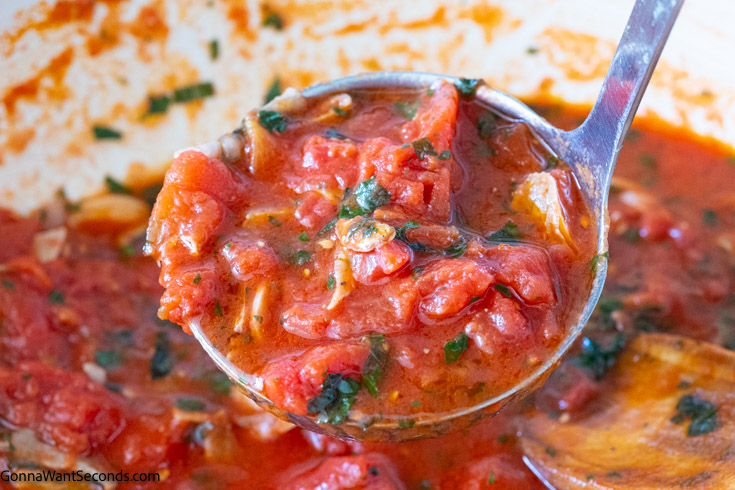
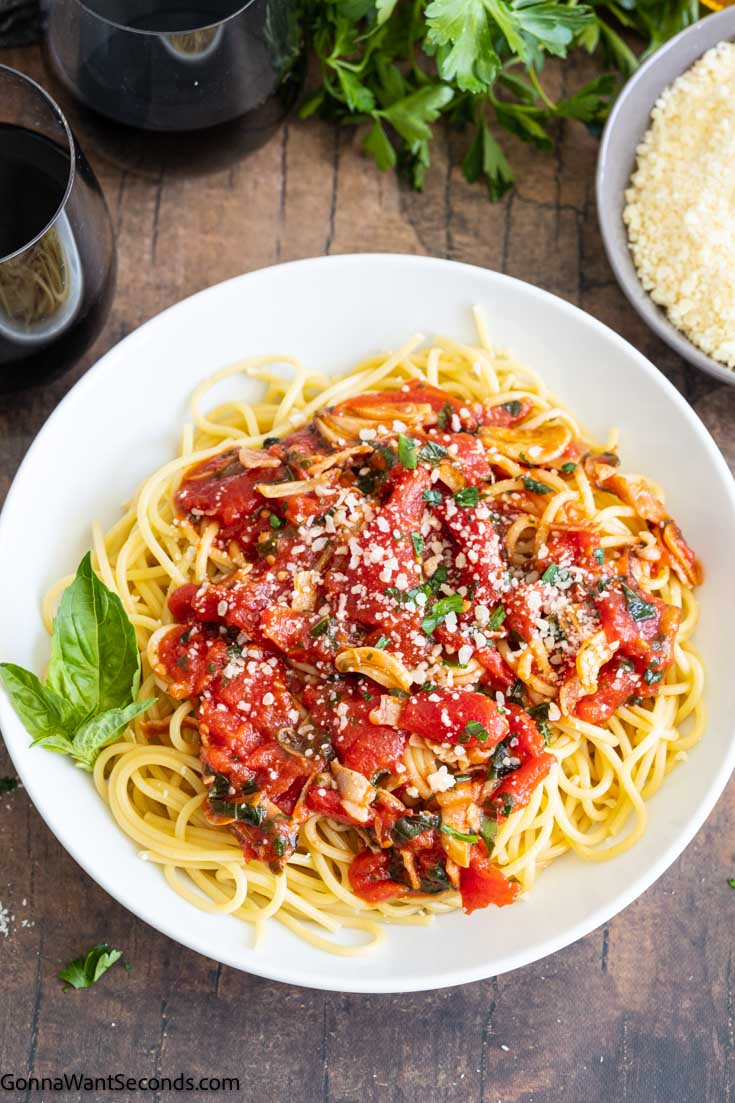
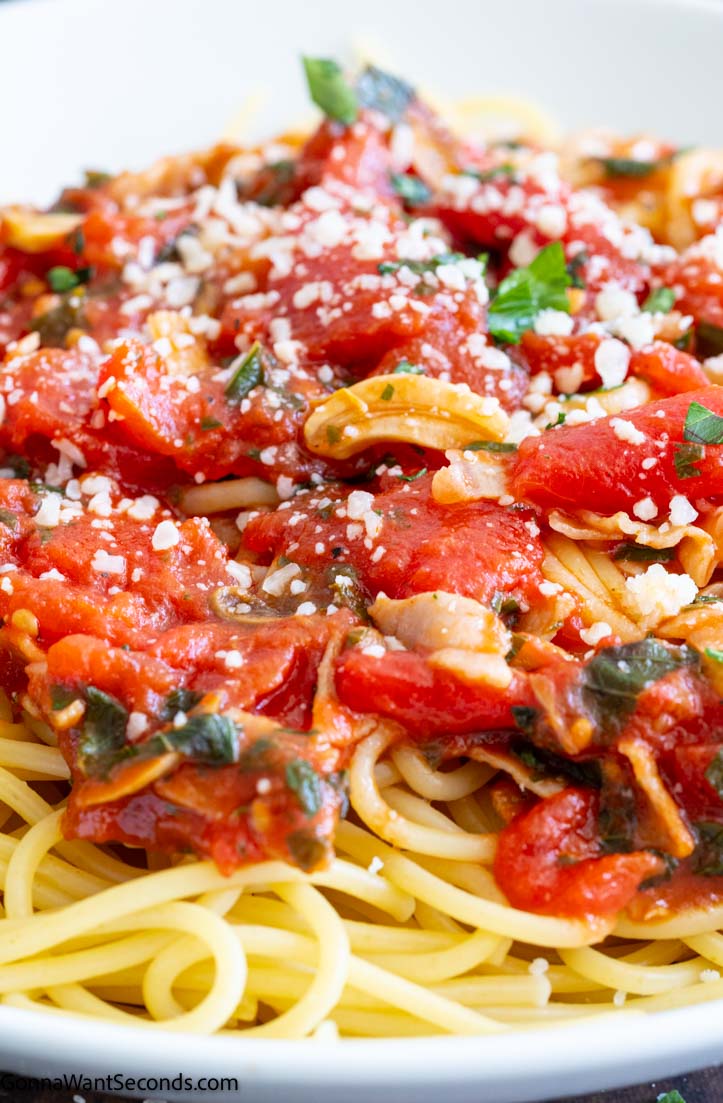
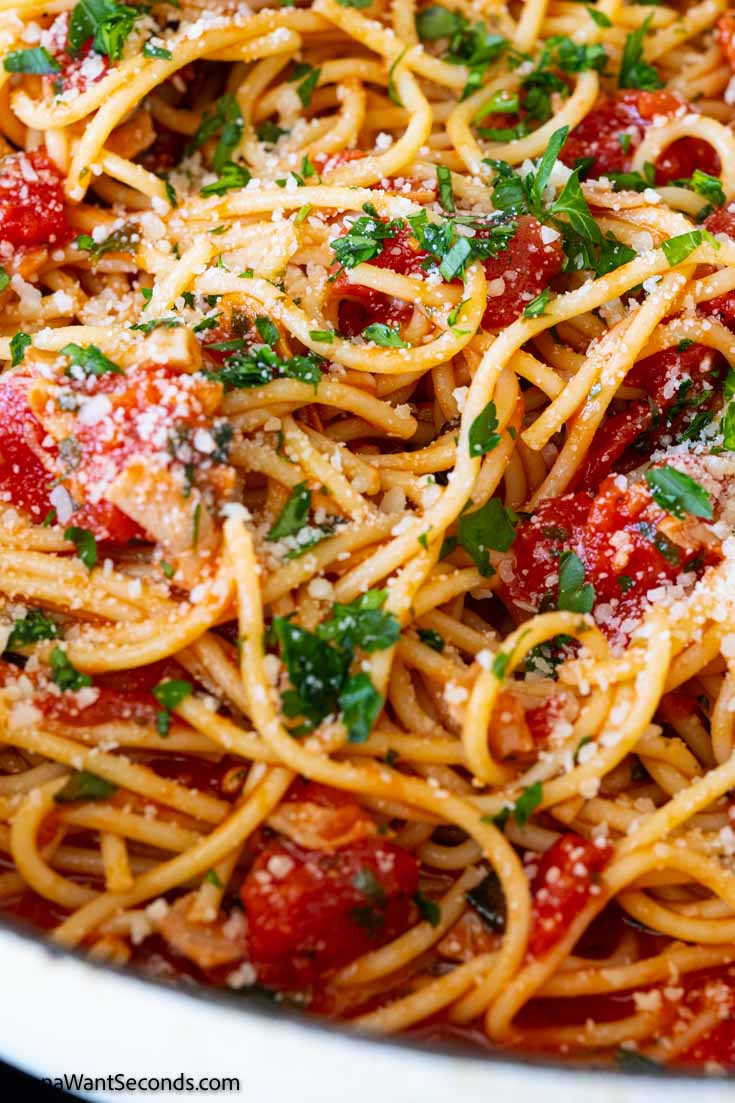

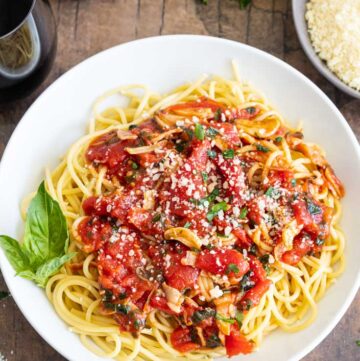
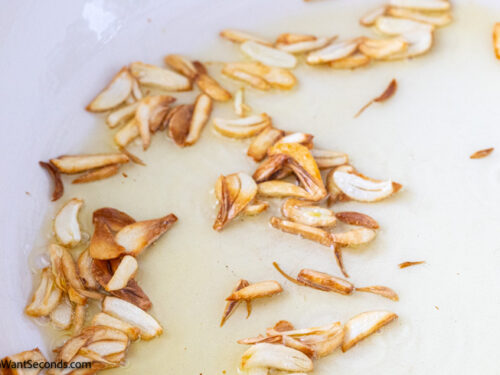
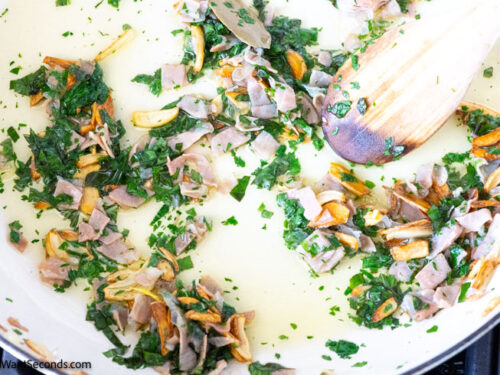
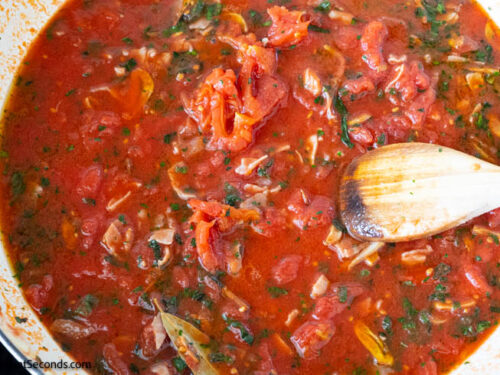
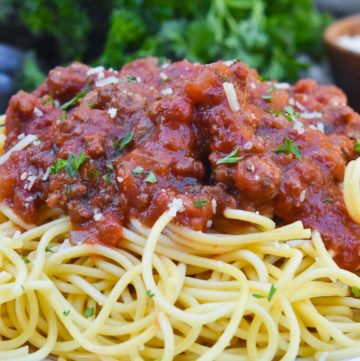
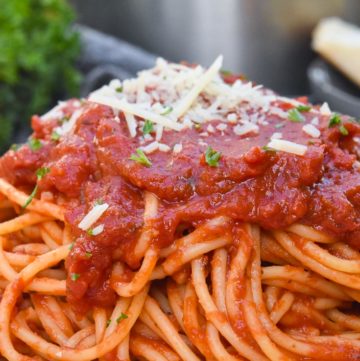
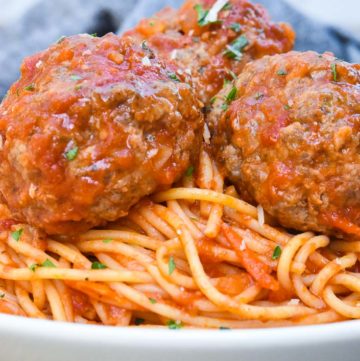
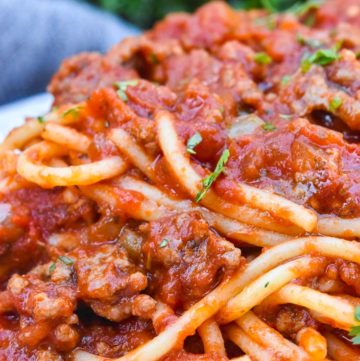


12 cloves of garlic????
Yes Ma’am!
List of ingredients calls for 1 can of tomatoes but step by step refers to 2 cans? I’m guessing 1 is correct but thought I should check for sure
Hi Anne. Yes it was a typo. The recipe calls for just one can 🙂
I love this! Been looking for homemade pasta sauce. This one is perfect!
So happy you enjoyed this sauce, Toni!